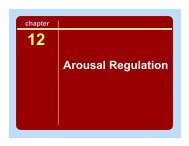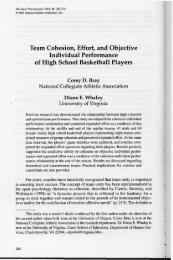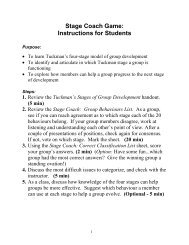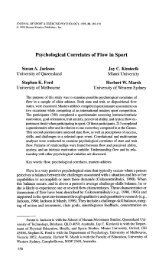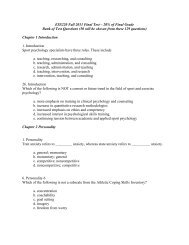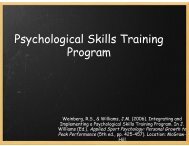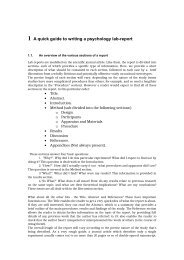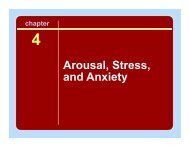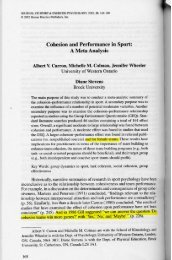Sport and Exercise Psychology Review - Sport Psychology Goes to ...
Sport and Exercise Psychology Review - Sport Psychology Goes to ...
Sport and Exercise Psychology Review - Sport Psychology Goes to ...
Create successful ePaper yourself
Turn your PDF publications into a flip-book with our unique Google optimized e-Paper software.
Chris<strong>to</strong>pher M. Spray & Richard J. Keegan<br />
ceived motivational climate in sport <strong>and</strong><br />
physical education do not exclusively focus<br />
on the promotion of competence (defined<br />
in mastery or performance terms) by significant<br />
social agents. For example, ‘perceived<br />
important role’ (mastery climate)<br />
<strong>and</strong> ‘unequal recognition’ (performance<br />
climate) are two climate dimensions that<br />
do not centre on competence explicitly.<br />
Nevertheless, we argue that these dimensions<br />
are important components of the<br />
‘perceived climate’ <strong>and</strong> will influence goal<br />
adoption.<br />
Those dimensions of climate that appear<br />
<strong>to</strong> be competence-based such as ‘effort/<br />
improvement’ (mastery) <strong>and</strong> ‘out performing<br />
others’ (performance) have been<br />
conceptualised within the definition component<br />
of competence <strong>and</strong> are primarily<br />
approach-focussed. To date, the valence<br />
component of competence has not been targeted<br />
intentionally, although closer examination<br />
of current measures reveals some<br />
avoidance-focussed elements where the concern<br />
would appear <strong>to</strong> be incompetence <strong>and</strong><br />
its consequences (e.g., ‘worry about mistakes’).<br />
Utilising qualitative procedures, we<br />
are currently examining how young athletes,<br />
coaches <strong>and</strong> parents perceive motivational<br />
climate in terms of the 2 x 2 model.<br />
This process should result in the development<br />
of measures <strong>to</strong> tap approach-avoidance<br />
elements of climate (in addition <strong>to</strong><br />
mastery-performance elements) for each of<br />
these social agents. We hope <strong>to</strong> identify the<br />
processes by which parents, coaches <strong>and</strong><br />
peers highlight the salience of approachavoidance<br />
forms of competence <strong>to</strong> young<br />
people in sport. Inclusion of the valence<br />
component of competence within climatebased<br />
research will hopefully provide a<br />
more complete picture of perceived situationally-emphasised<br />
goals <strong>and</strong> associated<br />
motivational processes <strong>and</strong> outcomes in<br />
sport (<strong>and</strong> exercise).<br />
Relationships among goals<br />
Elliot <strong>and</strong> Conroy (2005) referred <strong>to</strong><br />
the conceptual independence of the four<br />
approach-avoidance goals (p. 20). From an<br />
empirical perspective, the interrelationships<br />
among the four goals within the 2 x 2 model<br />
are likely <strong>to</strong> vary depending on the level of<br />
analysis (i.e., assessment of goals in relation<br />
<strong>to</strong> a specific context versus assessment of<br />
moment-<strong>to</strong>-moment goal states). The limited<br />
published research <strong>to</strong> date employing the<br />
2 x 2 framework in exercise <strong>and</strong> sport settings<br />
reveals positive intercorrelations. Utilising<br />
the Achievement Goals Questionnaire<br />
for <strong>Sport</strong> (AGQ-S), Conroy, Elliot & Hofer,<br />
(2003) found that achievement goals sharing<br />
the same definition or valence of competence<br />
were moderately correlated. Performance-avoidance<br />
<strong>and</strong> mastery-approach<br />
goals were weakly associated, whereas performance-approach<br />
<strong>and</strong> mastery-avoidance<br />
goals were moderately positively correlated.<br />
Research in the school physical education<br />
setting reveals similar patterns (Spray, 2005).<br />
It seems, therefore, that pursuing one goal<br />
does not preclude pursuing others, at least<br />
when the goals are framed in terms of a<br />
particular activity. Indeed, it is likely that<br />
participants strive <strong>to</strong> achieve multiple goals<br />
simultaneously in sport <strong>and</strong> exercise settings<br />
because of the number <strong>and</strong> variety of possible<br />
antecedents (Elliot, 1999). However,<br />
with the exception of the investigation by<br />
Gernigon et al. (2004), we have few data that<br />
examine the dominance of different goals<br />
during the execution of a physical task.<br />
Mastery-avoidance goal<br />
As the ‘new kid on the block’, the masteryavoidance<br />
goal is beginning <strong>to</strong> come under<br />
close scrutiny in sport <strong>and</strong> exercise psychology<br />
research. Elliot <strong>and</strong> Conroy (2005) presented<br />
some plausible examples of how<br />
athletes <strong>and</strong> exercise participants can<br />
become concerned with self- or task-referenced<br />
incompetence. As they point out, mastery-avoidance<br />
goals may be relevant in some<br />
contexts but not others (p. 20). Initial efforts<br />
<strong>to</strong> assess the four achievement goals in the<br />
physical education setting, using an adapted<br />
version of the AGQ-S, suggest that masteryavoidance<br />
goals are endorsed by young peo-<br />
48 <strong>Sport</strong> & <strong>Exercise</strong> <strong>Psychology</strong> <strong>Review</strong> Vol 1 No 2



